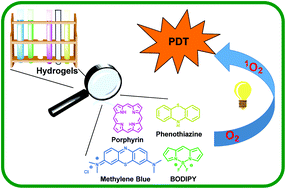Hydrogels: soft matters in photomedicine†
Abstract
Photodynamic therapy (PDT), a shining beacon in the realm of photomedicine, is a non-invasive technique that utilizes dye-based photosensitizers (PSs) in conjunction with light and oxygen to produce reactive oxygen species to combat malignant tissues and infectious microorganisms. Yet, for PDT to become a common, routine therapy, it is still necessary to overcome limitations such as photosensitizer solubility, long-term side effects (e.g., photosensitivity) and to develop safe, biocompatible and target-specific formulations. Polymer based drug delivery platforms are an effective strategy for the delivery of PSs for PDT applications. Among them, hydrogels and 3D polymer scaffolds with the ability to swell in aqueous media have been deeply investigated. Particularly, hydrogel-based formulations present real potential to fulfill all requirements of an ideal PDT platform by overcoming the solubility issues, while improving the selectivity and targeting drawbacks of the PSs alone. In this perspective, we summarize the use of hydrogels as carrier systems of PSs to enhance the effectiveness of PDT against infections and cancer. Their potential in environmental and biomedical applications, such as tissue engineering photoremediation and photochemistry, is also discussed.

- This article is part of the themed collection: 2019 Perspective article collection


 Please wait while we load your content...
Please wait while we load your content...